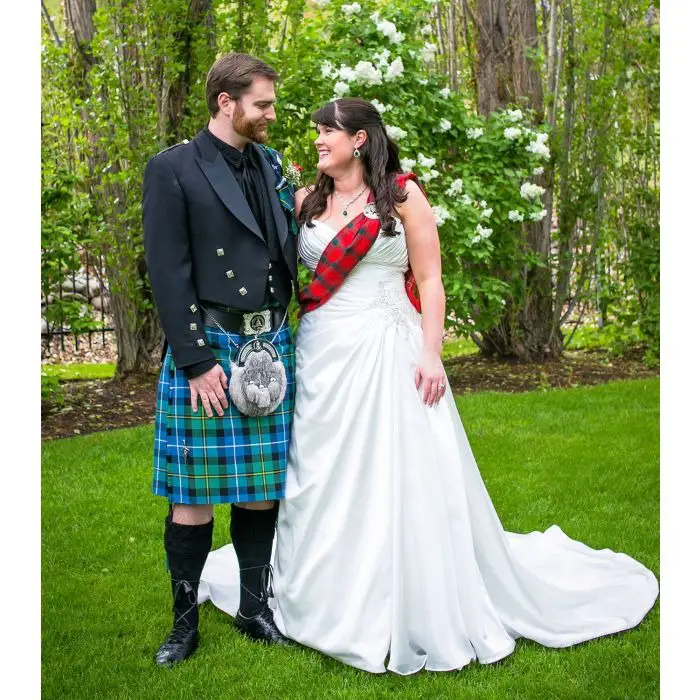When it comes to wedding attire, brides and grooms often spend months searching for the perfect outfits that not only reflect their personalities but also honor tradition. For grooms looking to infuse their wedding attire with heritage and a touch of panache, the kilt wedding outfit stands as an exceptional choice. A Kilt Outfit is more than just a piece of clothing; it's a symbol of Scottish culture and a timeless fashion statement that exudes elegance. In this article, we will delve into the world of kilt wedding outfits, exploring their history, components, and the various ways they can be styled for modern weddings.
A Brief History of the Kilt
Before we dive into the details of the kilt wedding outfit, it's essential to understand the historical significance of this iconic garment. The kilt is a traditional Scottish garment with a history that dates back centuries. While it's now synonymous with Scotland, the kilt's origins can be traced to the Celtic people of northern Europe.
The modern kilt, known as the “feileadh mòr” in Gaelic, as we recognize it today, emerged in the 18th century. It was popularized by Scottish Highlanders and eventually became a symbol of Scottish national identity. Over time, it has evolved from a practical piece of clothing worn for warmth and protection in the rugged Scottish Highlands to a formal and ceremonial attire.
Components of a Kilt Wedding Outfit
1. The Kilt
The centerpiece of the kilt wedding outfit is, of course, the kilt itself. Kilts come in a variety of tartan patterns, each representing a particular clan, region, or organization. Choosing the right tartan is a significant decision, often influenced by family heritage or personal preference. Grooms can even opt for a universal tartan if they don't have specific clan ties.
2. The Sporran
The sporran is a small pouch that hangs in front of the kilt, serving both decorative and functional purposes. It provides a handy pocket for carrying small items like wallets, keys, or tissues. Sporrans come in various styles, from simple leather pouches to ornate, tasseled designs. Choosing a sporran that complements the overall look of the kilt is crucial.
3. The Kilt Pin
A kilt pin is a decorative item that adds flair to the kilt. It's typically worn on the lower corner of the front apron of the kilt to keep it securely in place. Kilt pins come in a wide range of designs, often featuring Celtic symbols or clan insignias.
4. The Sgian Dubh
The sgian dubh (pronounced “skee-an doo”) is a small, traditional Scottish knife that is tucked into the top of the kilt hose (socks). While it is primarily decorative in modern times, it has historical significance as a tool for Highlanders. Like other kilt accessories, the sgian dubh offers an opportunity for personalization and style.
5. The Jacket and Waistcoat
In addition to his Scottish kilt outfit, grooms typically wear a formal jacket and waistcoat. These can be in traditional black, charcoal, or navy, or you can opt for a more contemporary look with tweed or tartan jacket and waistcoat combinations.
6. Footwear
Kilt hose (socks) and ghillie brogues (lace-up shoes) are the recommended footwear for a kilt wedding outfit. The socks are often held up with kilt flashes—decorative strips of cloth that match the kilt's tartan.
Styling Your Kilt Wedding Outfit
While adhering to tradition is important, there is also room for personalization and modern twists when it comes to styling a kilt wedding outfit.
1. Choosing the Tartan
Selecting the right tartan is a significant decision. Many couples choose a tartan that reflects their shared heritage, while others opt for a universal tartan that holds special meaning for them. Remember, there are no strict rules when it comes to tartan selection, so choose what feels right for you.
2. Accessorize Thoughtfully
The sporran, kilt pin, and sgian dubh offer opportunities to express your personality. Consider choosing accessories that hold personal significance or incorporate family symbolism.
3. Jacket and Waistcoat
The choice of jacket and waistcoat can dramatically affect your overall look. Traditional options offer timeless elegance, while tweed or tartan variations can provide a modern and unique twist.
4. Shirt and Tie
Selecting the right shirt and tie is crucial to tie the entire outfit together. Crisp white shirts are a classic choice, but you can also experiment with different colors and patterns for your tie.
5. Consider the Season and Venue
Think about the season and venue when planning your kilt wedding outfit. Lightweight, breathable kilts are ideal for warm weather, while heavier, warmer options are better suited for cold seasons.
6. Involve Your Wedding Party
Consider involving your groomsmen in your kilt wedding outfit choices. Coordinating outfits can create a cohesive and visually appealing wedding party.
Conclusion
The kilt wedding outfit offers grooms a unique and meaningful way to honor tradition while showcasing their personal style. With its rich history, diverse tartans, and customizable accessories, the kilt is a versatile choice for any wedding. Whether you opt for a classic, formal look or decide to put a modern spin on tradition, your kilt wedding outfit will undoubtedly make a statement on your special day. So, embrace the elegance and heritage of the kilt, and make your wedding a celebration of both love and culture.






